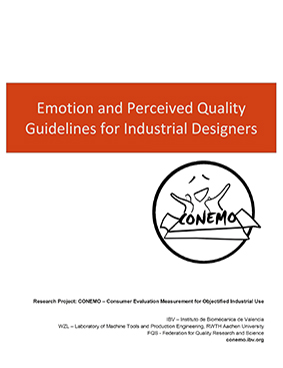
The perception of product quality is linked to emotions and these are affecting the purchasing decision. Therefore it is crucial for a company’s success to measure customers’ emotions objectively and integrate this awareness into processes of emotional product design. The question evolves which decisions are needed in order to design a product that evokes a positive emotional response.
It is very important that emotional information about products should be gathered and applied as early as possible in product development. Especially the semantic meaning and the visual impression of a product are relevant for perception in early phases. There is a need to combine visual impressions with different modalities for capturing and objectifying emotions. Rules are necessary to define a sufficient level of data as well as to communicate data to the person responsible for product development.
The research project CONEMO aims primarily at SMEs that produce products or services where customers’ Perceived Quality is of vital importance. These SMEs often have strong budget limitations and thus need to reduce and prevent possible failures in the design process.
In Europe 99% of the companies in the manufacturing industry are small and medium-sized regardless which sector they are situated in. For that reason CONEMO has a multi-sector approach. It has the potential of significant savings and increased effectiveness in the design process as well as savings in failure costs due to early involvement of customers and systematic use of Quality Gates.
To meet the diverse requirements of these companies CONEMO aims at a standardized procedure with an easy-to-follow guideline.
The users’ perception of products and services is one of the cornerstones in today’s companies’ success. Technical excellence combined with great Perceived Quality ensures good chances on the market which is affected by high market dynamics, pricing pressure and changing customers’ needs. Involving customer target groups is a standard procedure to help companies in the design and product development process(PDP).
Currently, the most usual approach is to use self-reporting methodologies like questionnaires to gather information about products from a customer. However, this approach has strong limitations, because it only measures what customers consciously think or want to think about a product. It does not give on-line information about unconscious reactions, thoughts or feelings towards the product which are the foundation of Perceived Quality measurement.
In the CONEMO project it is now the goal to show methods to obtain unconscious information, measure them objectively and show their importance in quality perception. Therefore, testing methods adjusted to the needs of SMEs are presented that are able to measure customers’ emotions.
This guideline gives a short overview on how to use emotions and quality perception for decision-making for an individual customer-centered product development. Step by step, it shows which aspects have to be considered and how to successfully deal with them. It is based on a Quality Gate systematics that can be used concurrent to the PDP and contains descriptions, requirements, measurement parameters, product structure and function.
The main aspects of this guideline are:
– Explanation of Emotion Evaluation
– Explanation of Product Development Process (PDP)
– Presenting the importance of integrating Emotional Quality Gates into the PDP
– Integration of Perceived Quality in early phases of product development
– Defining the strategy structure with the help of semantic concepts
– Defining the product structure with a systematic approach towards qualityperception
– Usage of an extended Quality Gate systematics to insure successful advancement of the developing product
– Outlook on an easy-to-use tool to assess and integrate affective design within the PDP

